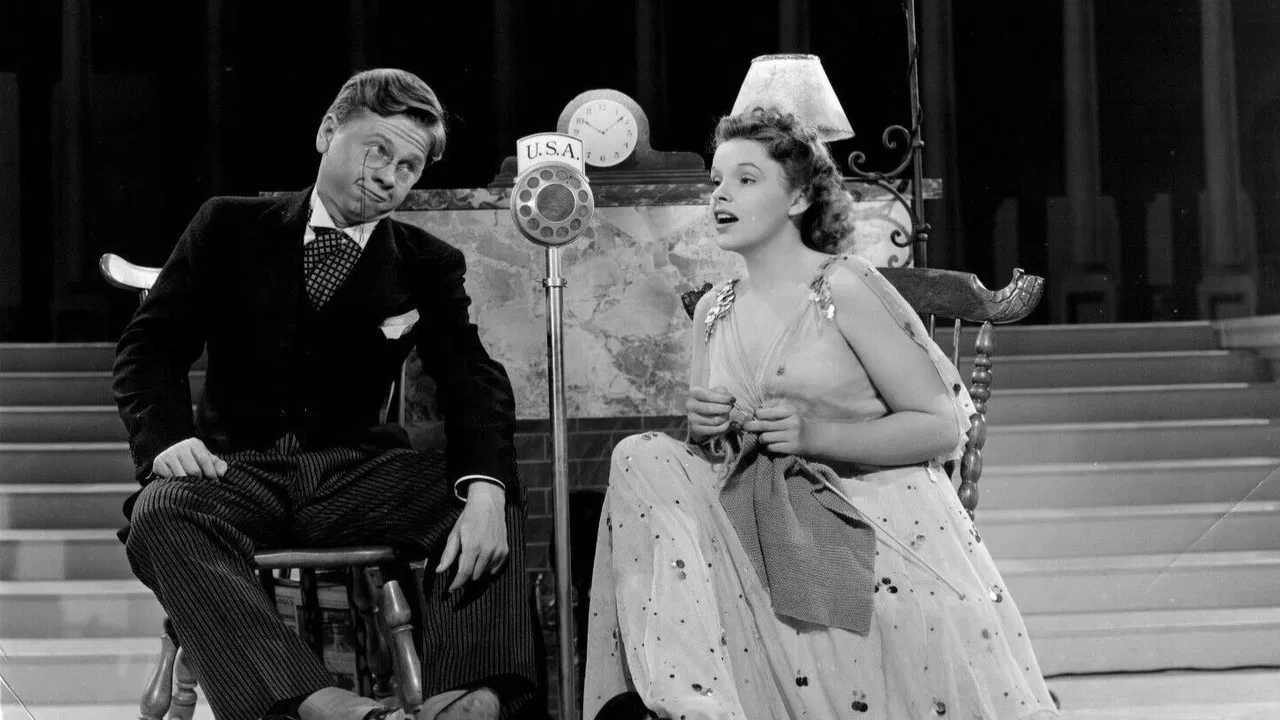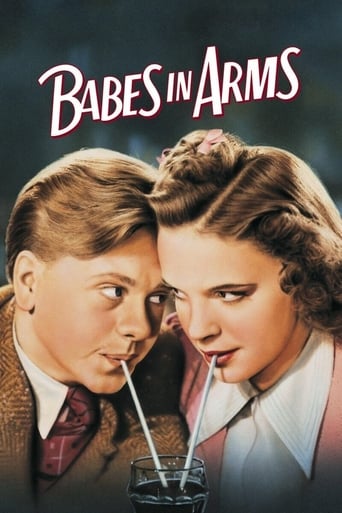

'Babes in Arms' is one of Richard Rodgers and Lorenz Hart's best musicals, and one of their biggest successes, with wonderful songs (some of their best) and a witty script.This film version starring Mickey Rooney and Judy Garland doesn't come up to its level. Although "Lady is a Tramp" is heard in brief instrumental form, the best songs from the musical don't appear and the script does lack the wit and sharpness of the stage show's, instead feeling bland and flimsy. Other flaws are that the story does lack oomph and sometimes drags and the supporting cast are variable, with the best performance coming from a very good Margaret Hamilton, Betty Jaynes and Douglas McPhail sing beautifully.June Preisser and Charles Winniger are terribly annoying however. My biggest complaint however is the minstrel number, there is no denying that it is exuberantly performed but there is a lot to dislike about the number, it is not for the easily offended, it appears randomly, feels out of place, goes on for far too long and has to be up there as one of the most overblown scenes in early film musicals.Flaws aside, there is still a good deal to enjoy in 'Babes in Arms'. While it is a bowdlerisation adaptation-wise, the songs are still of good quality, it was interesting to hear "Good Morning", "Broadway Melody" and "Singin in the Rain", while "You are My Lucky Star" and especially the poignant "I Cried for You" are the standouts. "God's Country" is the sole misfire. The use of pre-existing material and operatic excerpts are also a delight, as are the sumptuous production values and lavish photography. Busby Berkeley's direction is not as imaginative, witty or dazzling as some of his other films, but it doesn't come over heavy-handedly and it has charm and energy, especially the clever staging of the title number.As said, the supporting cast are variable, but it's Mickey Rooney and Judy Garland that make 'Babes in Arms' worth seeing. Their chemistry shines beautifully, his brashness contrasting beautifully with her vulnerability. Rooney's performance does feel excessive and hammy sometimes and when it comes to the Oscar nomination he was nowhere near to the level of the other nominees in my opinion, however the boundless enthusiasm is there as is the charm. Garland is luminous and incredibly touching, her voice is also one that you can listen to for hours and not get enough of.On the whole, has a lot to like, especially Rooney, Garland and their chemistry, but it is patchy too. 6/10 Bethany Cox
... View MoreJudy Garland, after her sweet, innocent role as Dorthy stars in her next first of several wonderful musicals with Micky Rooney. "Babes in arms" has some very touching, very nice songs in it. After Judy singing "Over the rainbow" like an angel in "Oz", she now sings some more songs in the same way starting with "Good morning". Amazing voice, wonderful song. But so are all of Judy's songs. Then she does this sing off with Betty Janes, Judy singing swing style and Betty singing opera. This is a good take off from "Every Sunday" where Judy does the same style sing off with Deanna Durbin. Deanna and Betty both have wonderful opera voices so they could've used either actress for this film and I think it would've been just as good either way. I love Deanna too. I believe the idea of her taking a part with Judy in this film was brought up during the making of it, that they wanted to make it sort of an "Every Sunday" sequel bit or reunion of a sorts, but she was unavailable for taking any parts at MGM due to her contract at Universal. I love Deanna's songs "Dannyboy" and "Because". Anyways back to this film, Mickey hams it up a little bit too much in this film in a couple scenes such as the over hyper way he acts when he receives $100 after singing "Good morning" with Judy. It is part of his goofy persona, which sometimes in my opinion treads on the line between OK and too much, but Mickey can be tough also which does indeed improve his image. He played a tough kid in 'Thoroughbreds don't cry' and he knew how to fight in that film, and he also does in the scene here in the soda shop where a guy picks a fight with him for advancing on his date, June Pressier. June is a sweet actress who also has some amazing gymnastics tumbling skills. She comes back in "Strike up the Band" to show us more of this in the stage number "Ta ra ra boom da lay". June fancies Micky and invites him to dinner. I liked that scene and where Mickey needs to be reminded by the butler which silverware to use, and that he doesn't quite know how to smoke a cigar. The quirky stuffy butler with that semi English, strong mid Atlantic accent is the same guy who plays the desk clerk at the studio in another film with Judy "Broadway Melody 38" (scene where Judy sings "everybody sing"). Judy fancies Micky too, but she gets hurt because he only likes her as a friend and she wanted romance. This exact same thing was also in "Strike up the band" and "Love finds Andy Hardy". I enjoyed Mickey's impersonation of Clark Gable and John Barrymore during rehearsals. I won't give away any more to spoil the plot. More great songs in this film were "Where or when" and "Babes in arms" when Judy, Mickey and company were walking down the street collecting more people leading to a great chorus with everyone dancing in all these circles on the playground. The tall guy with the talented opera voice leading both of those songs was also a live interest of Judy's in the very nice film "Little Nelly Kelly". This and many other of Judy Garland's musicals are wonderful. Judy Garland is wonderful. And the other characters in these films are great too.
... View MoreWow, I just finished watching "Babes in Arms", and my head is spinning. We old movie fans are used to seeing ethnic humor and even the occasional bit of blackface in early Hollywood films; but what "Babes in Arms" gives us is outrageous by any definition: an entire cast of a "show within a show", numbering at least 50 to 75 people, including Mickey Rooney and Judy Garland, every one in blackface, performing not just a minstrel skit, nor a single musical number, but an entire 20 minute full-blown minstrel show in spectacular MGM full-production mode. It goes on and on and on. Dialect jokes. Banjoes and songs about Alabammy. And finally, Judy Garland, having removed her blackface, comes out and performs an additional number ("I'm Just Wild About Harry") as an only slightly darkened black woman. Wow.On the other hand, is it really possible that the manic Mickey Rooney was only 19 when he made this? He really shows why he may be the single most talented American performer of the last century. He dances, he sings, he does drama, he does comedy, and he has incredible control over his every move and muscle. And he does unbelievable and hilarious impressions of Clark Gable and Lionel Barrymore. And Franklin Roosevelt.A few quick notes: June Priesser, who plays "Baby" Rosalie, was a terrible actress. But watch out for her stomach-churning contortionist back-rolls when she first comes out on a stage.The child actor who plays Mickey Rooney at age 5 dancing on a Vaudeville stage for a few moments early on really does look like Mickey Rooney! I think Judy Garland actually has some of the same lines in this movie as she does in "Wizard of Oz", done in this same year. Watch out for when Mickey Rooney feints early in the film; Garland reacts to this exactly, and I mean exactly, as she does in Oz when the Lion feints. Eerie! When Judy Garland, as Eleanor Roosevelt, sings "My day, my day", she is referring to an actual long-running newspaper column written by E.R. from 1936 to 1962.Finally, the final song and dance number is the most mind-numbing, over-the-top tribute to America, dancing, how we are not Nazis, American Indians, Asian Indians, dancing, the Roosevelts, and dancing, that I have ever seen. Yes, it was early WWII, but still, you wonder if anyone even in 1939 thought this was a little too much? Recommended for its high energy, its Rooney and Garland, its more Rooney, its offensiveness, and its too much of everything. It is history, and should be watched by all.
... View MoreBabes in Arms (1939) ** 1/2 (out of 4) MGM musical was clearly produced to try and show off their young talent. Kids of vaudeville families need to raise some cash because the talkie's are killing their parents careers. Mickey Rooney and Judy Garland play two of the teens who decide to put on a show to raise money and show that vaudeville can be popular like it once was. I had heard a lot of great things about this film but in the end it was rather middle ground more than instant classic. There's a lot to enjoy here but in the end the story itself is rather weak. I guess you really can't blame the studio too much as they were clearly just using this as a way to check their young stars and see who could cut it and who couldn't. The funny thing is that we've got Rooney acting just like he did in BOYS TOWN and Garland acting sweet and innocent, which would become her staple. There's also Margaret Hamilton playing the same type of character that she'd also play in THE WIZARD OF OZ. Rooney and Garland do great work together and their chemistry really jumps off the screen and that includes the film's greatest moment where the two sing "Good Morning". "Oh, Susanna" makes for a very strange moment near the end where we get a minstrel show with Rooney and Garland in blackface. This sequence really stands out and is quite strange to watch today but if you watch enough of these old movies you'll see that many A-list stars appeared in blackface. Guy Kibbee, Charles Winninger, Henry Hull, Grace Hayes and Joseph Grehan round out the cast. One of the more interesting scenes is one where Rooney acts out a scene and impersonates Clark Gable and Lionel Barrymore. In the end, this is a pretty nice film that fans of the stars will want to see but this certainly isn't the masterpiece some make it out as.
... View More